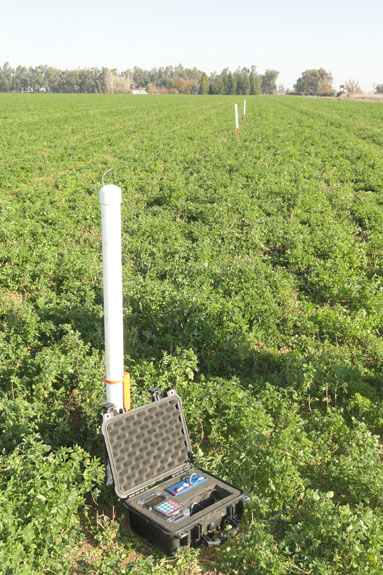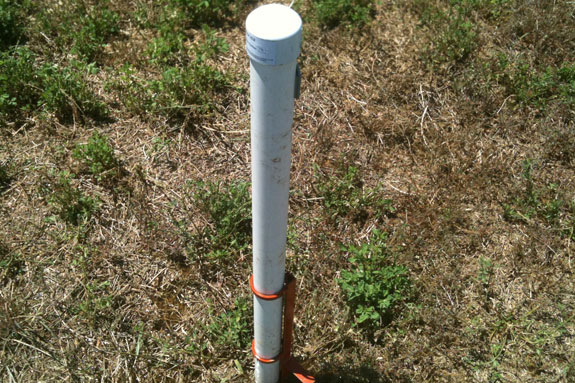Researchers at UC Davis have developed a wireless wetting-front monitoring and a cellular communication system for use in flood-irrigated alfalfa and other surface-irrigated crops. Using individually numbered wireless sensors placed in the field, water arrival to a specific location is detected.
The location of the sensor within the check is determined by the irrigator. Upon detection of the wetting-front, these sensors send a signal to a ‘central module’ located within a 1.5-mile range. The module has the ability to identify the sensor and send cellular text messages to irrigators alerting them of water arrival in a specific check.
 Sensor poles and central module (black case) in an alfalfa check, with metal “step-stake” for easy install.
Sensor poles and central module (black case) in an alfalfa check, with metal “step-stake” for easy install.
The ‘central module’ can monitor up to 255 of these sensors – though most growers generally only need a few of them (four to six) – and requires a cellular texting plan to be fully operational. It runs on a 12-volt lead-acid battery, which has been shown to last throughout most irrigation events (two to four days).
The individual sensor poles, designed to be both durable and waterproof, use only a standard 9V battery that lasts an entire growing season. Fittings and a metal 'step-stake' have been included with the poles to ensure that false sensing does not occur and that the sensors can stand upright even in saturated soils.
Field tests have shown that placing a sensor at a location in the field that corresponds to the water cutoff location can be used to improve water use efficiency (WUE) by minimizing tail discharge.
In this case, the sensors provide an alert system to ensure that irrigators know where the water is in the field, without constant supervision, and can use that information to make sure they are cutting water at the correct location.
Testing in Western Yolo County illustrated that using these sensors as a cutoff strategy could reduce surface runoff to near-zero levels from the more common 15 to 25 percent of applied water.
This system currently depends on the irrigator’s judgment as where to place their ‘cutoff location,’ since the sensors only alert when water has reached a specific location. Current research has focused on developing a more advanced system that monitors the wetting-front advance rate and automatically decides when the irrigator should cutoff the water.
 Individual sensor pole.
Individual sensor pole.
In this case, it not only detects water arrival but also determines the proper cutoff location to minimize tail discharge, if additional information such as check inflow rate and field geometry are given. This gives the irrigator a better idea of when to cutoff water regardless of where the sensors are placed in the field.
In theory, this advanced system could be used with certain inflow methods (ex. weir gate or pump-based) to turn on/off inflow and automate the entire irrigation process. For more information about this system, click here to email Shrini Upadhyaya or call (530) 752-8770.
Brad J. Arnold, Shrini K. Upadhyaya and Jedediah Roach are from the Biological and Agricultural Engineering Dept. (UC Davis). Parasappa Kannanavar is from the University of Agricultural Sciences-Raichur, India. Daniel H. Putnam is a UC Extension Agronomy and Forage Specialist.









